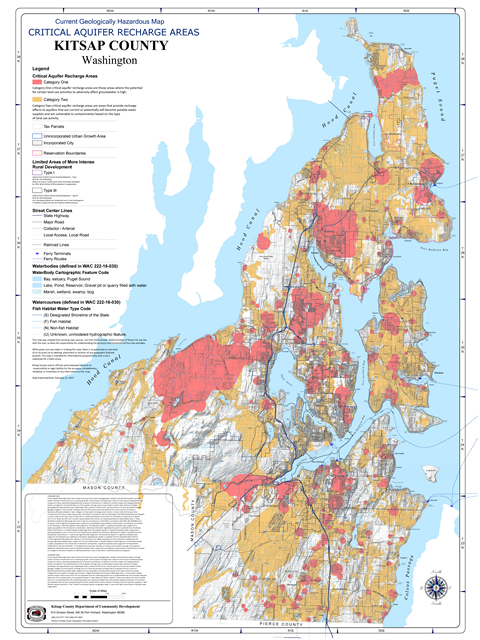 | Critical Aquifer Recharge AreasCritical Aquifer Recharge Areas means those land areas that contain hydro geologic conditions that facilitate aquifer recharge and/or transmit contaminants to an underlying aquifer. Critical aquifer recharge areas under this title may be established based on general criteria, specifically designated due to special circumstances, or based on scientific studies and mapping efforts. Factors considered in the identification of critical aquifer recharge areas include depth to water table, presence of highly permeable soils (specifically Group A Hydrologic Soils), presence of flat terrain, and the presence of more permeable surficial geology. |
|---|
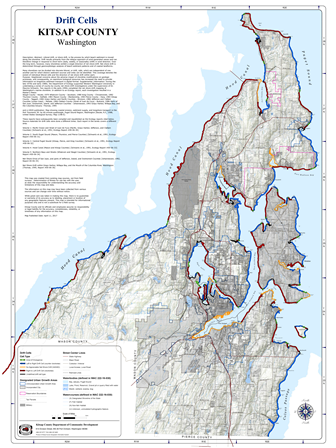 | Littoral drift, or shore drift, is the process by which beach sediment is moved
along the shoreline. Drift results primarily from the oblique approach of wind-generated waves and can therefore change in response to short-term (daily, weekly, or seasonally) shifts in wind direction. Over the long term, however, many shorelines exhibit a single direction of net shore drift. Net shore-drift is determined through geomorphologic analysis of beach sediment patterns and of coastal landforms. |
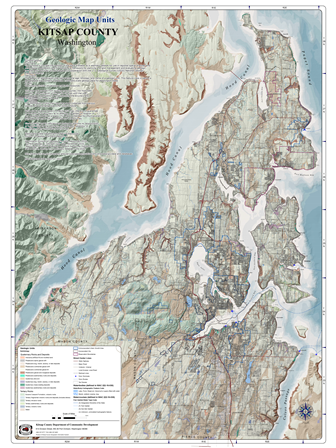 | Surface Geology is used for regional spatial analyses and other digital applications and for providing a framework for planning and land management and evaluating geologic hazards and resources. |
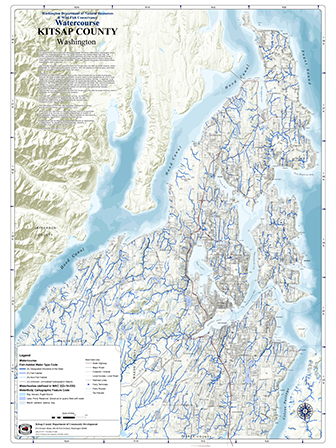 | The Watercourse (WCHYDRO) and Water Body/Water Shoreline (WBHYDRO) Hydrography layers support the implementation of the new Forest Practices Fish Habitat Water Type Map. The primary purpose of the data is to aid in the application of timber harvest and other forest practices regulations and activities by the Washington State Department of Natural Resources (DNR) within the forested areas of the state. Other uses include cartography and analysis where hydrographic data is required. Also included here are areas where the Wild Fish Conservancy has field-surveyed streams, where accessible, for fish presence and overall condition. WFC will expand on these surveys, and these areas will increase in extent, likely every two years. |
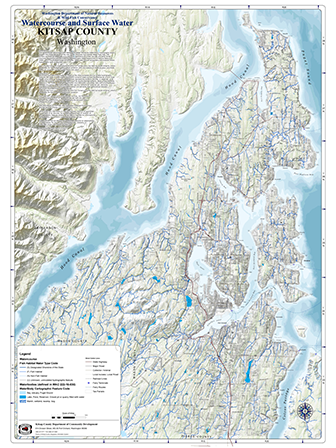 | WCHYDRO and WBHYDRO together make up the most complete and up to date hydrography layer for the State of Washington. WCHYDRO contains watercourses represented as arcs or lines. These occur alone as single arc watercourses representing streams, ditches, or pipelines, or as centerlines through water body polygons such as double-banked streams, lakes, impoundments, reservoirs, wet areas, or glaciers. WBWS (WBHYDRO) and WC (WCHYDRO) are edited daily and simultaneously; updates are posted weekly for internal DNR use and monthly for external use. Attribute interrelationships within WBWS (WBHYDRO) and spatial and attribute interrelationships between WBWS (WBHYDRO) and WC (WCHYDRO) are maintained. |
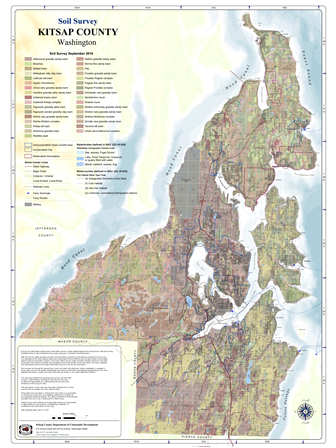 | Information for SOILS data layer was derived from the Private Forest Land Grading system (PFLG) and subsequent soil surveys. PFLG was a five-year mapping program completed in 1980 for the purpose of forestland taxation. It was funded by the Washington State Department of Revenue. The Department of Natural Resources, Soil Conservation Service (now known as the Natural Resources Conservation Service or NRCS), USDA Forest Service and Washington State University conducted soil mapping cooperatively following national soil survey standards. Private lands having the potential of supporting commercial forests were surveyed along with interspersed small areas of State lands, Indian tribal lands, and federal lands. |
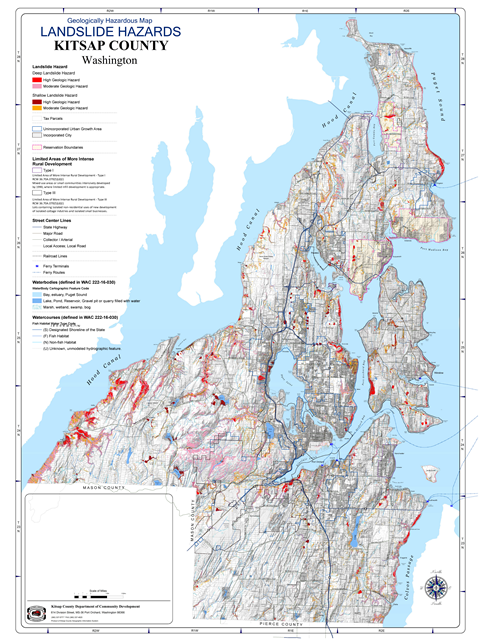 | Deep Seated Landslide Inventory are polygons that represent the outline of landslide deposits, landslide toe, and landslide headscarp. Shallow landslide hazards which polygons show areas of high and moderate shallow landslide hazards. |
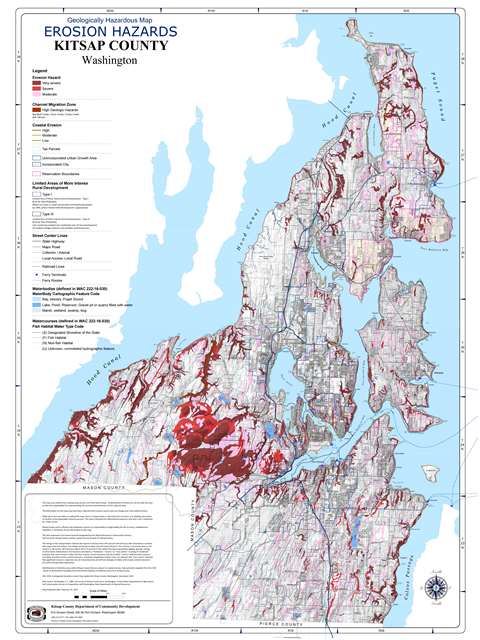 | The data represents soil erosion hazards designated by the Natural Resources Conservation Service, Soil Survey for Kitsap County and the coastal erosion hazards for Kitsap County. The ratings in this interpretation indicate the hazard of soil loss from off-road and off-trail areas after disturbance activities that expose the soil surface. The ratings are based on slope and soil erosion factor K. The soil loss is caused by sheet or rill erosion in off-road or off-trail areas where 50 to 75 percent of
the surface has been exposed by logging, grazing, mining, or other kinds of disturbance. The hazard is described as "moderate," "severe," or "very severe." A rating of "moderate" indicates that some erosion is likely and that erosion-control measures may be needed; "severe" indicates that erosion is very likely and that erosion-control measures, including revegetation of bare areas, are advised; and "very severe" indicates that significant erosion is expected, loss of soil productivity and off-site damage are likely, and erosion-control measures are costly and generally impractical. Identification of shoreline areas within Kitsap County that are subject to coastal erosion. |
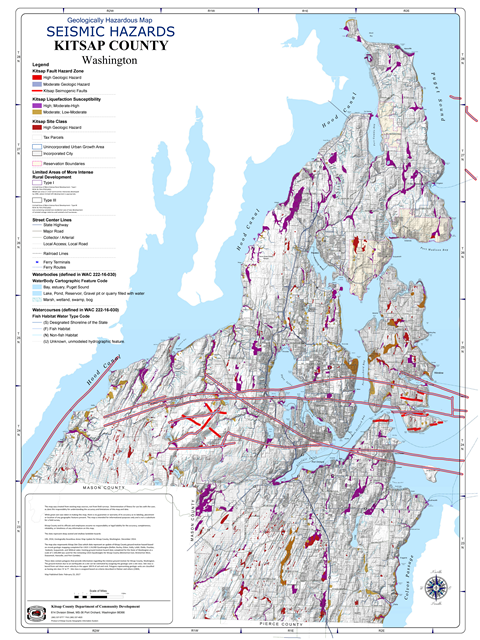 | This map displays data that is a derivative of potential seismogenic fault data that was compiled as part of the Data Preservation Program of the Washington Division of Geology and Earth Resources in August 2013. These data represent the fault hazard zone where potential for fault rupture hazards could occur during an earthquake along the fault for Kitsap County. The purpose of the data is to represent areas in the vicinity of potential seismogenic faults. The map also includes data that represents an update of Kitsap County's liquefaction hazard on recent geologic mapping completed for USGS 1:24,000 Quadrangles (Belfair, Burley, Eldon, Holly, Lofall, Olalla, Poulsbo, Seabeck, Suquamish, and Wildcat Lake). Existing liquefaction hazard data completed for the State of Washington at a scale of 1:100,000 was used for the remaining USGS Quadrangles for Kitsap County (Bremerton East, Bremerton West, Duwamish, Hansville, and Port Gamble) |
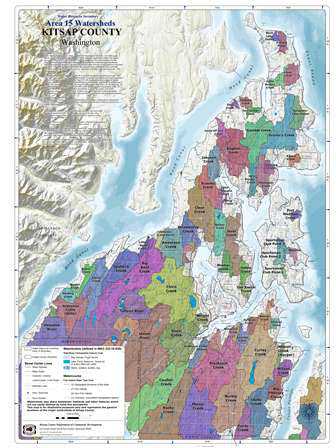 | Water Resource Inventory Areas (WRIA) for Washington State at 1:24,000 scale. WRIAs were formalized under WAC 173-500-040 and authorized under the Water Resources Act of 1971, RCW 90.54. Ecology was given the responsibility for the development and management of these administrative and planning boundaries. These boundaries represent the administrative under pinning of this agency's business activities. The original WRIA boundary agreements and judgments were reached jointly by Washington's natural resource agencies (Ecology, Natural Resources, Fish and Wildlife) in 1970. Watersheds may share headwater wetlands and other features which are not easily defined by hard-line boundaries. This map is for illustrative purposes only and represents the general locations of the major watersheds of Kitsap County |
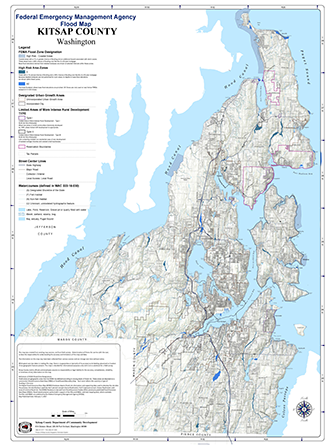 | A Flood Insurance Rate Map (FIRM), Flood Boundary and Floodway Map (FBFM), and Flood Hazard Boundary Map (FHBM) are all flood maps that have been produced by FEMA. The FIRM is the most common map and most communities have this type of map. At a minimum, flood maps show flood risk zones and their boundaries, and may also show floodways and Base Flood Elevations (BFEs). The FBFM is a version of a flood map that shows only the floodway and flood boundaries. The FBFM is no longer produced; current FIRMs include all of this information. The FHBM is an older version of a flood map and is based on approximate data. |

